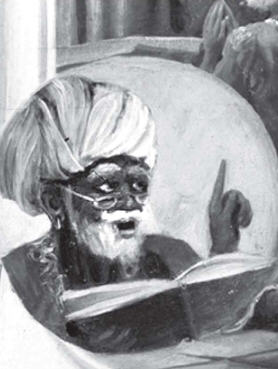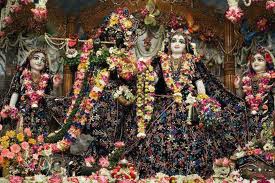Religious zealots force twisted interpretations to suit their selfish propaganda
A religious zealot, famed for his so-called knowledge of the Vedas, quotes Yajur Veda (32.3) to prove that God has no form. Whether God has a form or not according to Vedic scriptures is a secondary point. It’s more important to first question the authenticity of the references used by this speaker.

For instance, let us take the verse from Yajur Veda in question. The preacher excitedly quotes1:
na tasya pratima asti: “There is no image of Him.” (Yajur Veda 32.3)
Interestingly he also quotes Svetasvatara Upanisad (4.19) which has a similar verse:
na tasya pratima asti: “There is no likeness of Him.”
Note the difference in the translation of the same verse appearing in two different scriptures. Why does the speaker give a different translation for the same verse? Also, in both the quotations, he has quoted only half the verse. The complete verse from the Svetasvatara Upanisad (4.19) says,
“No one can grasp Him above, across, or in the middle. There is no likeness of Him. His name is Great Glory.” 2
However, only the middle phrase of the verse is selected. Imagine telling a Muslim that the holy Koran says, “There is no God.” When a Muslim demands to know where in the Koran it is said there is no God, we quote the fourth Surah, 87th Ayat. If he then expresses shock and incredulity, we give the reference, “The holy Koran, translated by Abdullah Yusuf Ali, Goodword Books, page number 58. He will certainly then open the concerned book and find the complete verse that says, “There is no God… except Allah.”
Or we could give another example from the holy Koran, 53rd Surah, 23rd Ayat which says, “Allah has sent down no authority whatsoever.” 3 The exact words used are ma anzala i-lahu min sultanin in. Ma means “not,” and anzala and i-lahu mean “Allah has sent down.” Min, a preposition, refers to “any” and sultanin, a genitive masculine indefinite noun, translates as “authority.” Again the negative particle in is used to indicate “No.” Based on this verse we can say that Prophet Mohammed is also not an authority because he isn’t sanctioned by Allah. The verse is emphatic on there being no messenger of God. However, a Muslim may protest and implore us to read the whole chapter because that might give us a different understanding.
Similarly, when someone quotes Vedas and Upanisads out of context, only to fulfill one’s own hidden and nasty agendas, we shouldn’t take it seriously. The meaning of the word pratima when used in reference to God and in the context of Vedas refers to “likeness.” The word pratima according to Vedic Sanskrit dictionary4 refers to similarity. The Vedas clearly emphasize that God has no equal or no similarity. This, however, doesn’t mean he has no form. Another word in the verse is asti. Asti means “to be,” “to exist,” “to live,” or “to constitute.” The verse therefore begs to be translated as “there is no one living or existing in any way similar to Him.” Yes, the verdict of the Vedic literatures is God is one without a second. But that doesn’t mean He has no form. The Islamic preacher and his followers should read the 112 principal Upanisads before concluding that God is formless.
For example, the Gopala-tapani Upanisad 5 (1.10, 1.35, 1.1, 1.24) speaks about the form of the Supreme Lord. Tthe Katha Upanisad6 (2.2.13, 2.3.10 to 16) also explains the form of God.7 This is also confirmed in the Svetasvatara Upanisad (3.8-9),8 which substantiates the above verses by saying, “I know that Supreme Personality of Godhead, who is transcendental to all material conceptions of darkness. Only he who knows Him can transcend the bonds of birth and death. There is no way for liberation other than this knowledge of that Supreme Person. There is no truth superior to that Supreme Person, because He is the super most. He is smaller than the smallest, and He is greater than the greatest. He is situated as a silent tree, and He illumines the transcendental sky, and as a tree spreads its roots, He spreads His extensive energies.”
From these verses, one concludes that the Supreme Absolute Truth is the Supreme Personality of Godhead, who is all-pervading by His multi-energies, both material and spiritual.
In fact, the Koran itself mentions God’s form. One can read the following verses from the Koran to be convinced that God has form:
Surah: Ayat (Chapter: Verses): 55.27, 20.39, 96.14, 52.48, 20.39, 54.14, 38.75, 39.67, 48.10, and many more from the Hadiths.
(Translated by Dr. Muhammad Taqi-ud-Din Al-Hilali and Dr. Muhammad Muhsin Khan and approved by the Ministry of Islamic Affairs, Saudi Arabia and published world over by the Saudi Kingdom for free distribution through their Embassies in different countries)
However, the most appalling audacity of this speaker lies in inventing verses and presenting only half the verses! Let us see how.
There are two primary versions of the Yajur Veda: Sukla-yajur Veda (White) and Krsna-yajur Veda (Black). Both contain verses necessary for rituals. 9
Gullible people are impressed to hear him quoting chapter numbers and verse numbers from rote memory, but you can see for yourself how his references are pathetically poor. Before quoting 32.3, he first needs to specify which version of the Yajur Veda he is referring to. Let us first take the Black Yajur Veda. 10 This has seven khanhas, or cantos. Each of these cantos has less than eight chapters (total of 44 chapters). The correct way of quoting a reference from the Yajur Veda would be [Canto no, chapter no, verse no, Black / White Yajur Veda]. But as it turns out this is the least of the preacher’s intellectual sloppiness. When he says it’s 32nd chapter, let’s assume it is the sixth chapter of the fifth khanha. (Because sequentially it becomes the 32nd chapter; first canto has eight chapters, second has six, third has five, fourth has seven, fifth has seven, sixth has six, and seventh has five chapters). Now let us take the third verse of this chapter (as it becomes 32.3, as per his quotation). The verse extols the glories of Varuna, Brhaspati and Indra. There is no mention of Supreme God and His having no form. 11

Maybe he has referred to the White Yajur Veda. Let us then examine this scripture.
The White Yajur Veda has forty chapters12. The 32nd chapter offers oblations to Vayu, Candra, Surya and Agni. The third verse specifically talks about the source of all the demigods:
“There is no counterpart of him whose glory verily is great. In the beginning rose Hiranyagarbha, Let not him harm me. He is unborn. He deserves our worship.”
How can one who claims to be a teacher of comparative religion ignore the whole verse, take only a part of it, and distort the meaning of this verse to suit his interests? Either it is due to his sloppiness or his slyness. We leave the decision up to our intelligent readers.
One should also note that the White Yajur Veda exclusively deals with rituals and it does not give philosophical conclusions. The Black Yajur Veda contains little more explanatory material about the rituals.13 However, both texts primarily lay down rules for the performance of various sacrifices and do not offer conclusions on God’s form. To conclude about the form of God based on some abstruse verse and to confuse innocent Hindus seems to be the occupation of this cheater.
Then what is the source of the speaker’s Yajur Veda quotes? He claims to have taken the translations of Yajur Veda from Devi Chand. Let us see the credentials of Mr. Devi Chand.
Devi Chand is a disciple of Swami Dayananda Sarasvati. Dayananda Sarasvati was heavily influenced by the Christian criticism of idolatry during his times. Dayananda Sarasvati, like his Christian critics, could not comprehend the difference between idols and deities, and so he concocted his own version of Hinduism, which not only rejected deity worship but also rejected the form of the Absolute Truth. This rejection was in flagrant violation of the many scriptural references to the form of God and the description of Deity worship in the Païcaratra sastras and the silpa-sutras. Following in Dayananda Sarasvati’s unfortunately misled footsteps, Devi Chand has distorted the Yajur Veda texts, which were in vogue three thousand years ago. Therefore, this speaker should not refer to speculations on Vedas by those who study Vedas with an ulterior motive, but rather he should study the Vedas under a guru, a spiritual master, who comes in the proper disciplic succession.
Of course, such a speaker is unlikely to change his perverse ways, but we request our truth-cherishing, intelligent readers to help innocent people to see through the fallaciousness and the maliciousness of such presentations by widely circulating articles like these.
Vraja Vihari Dasa, MBA, serves full-time at ISKCON Mumbai and teaches Krsna consciousness to students in various colleges.
